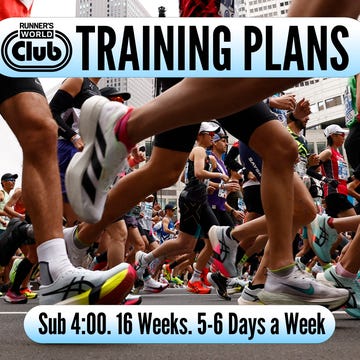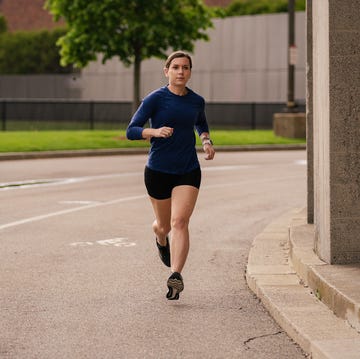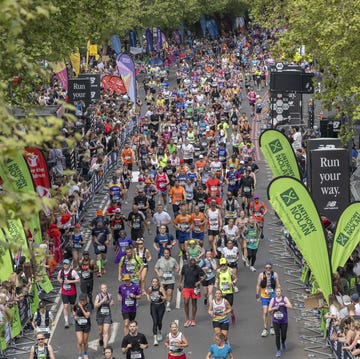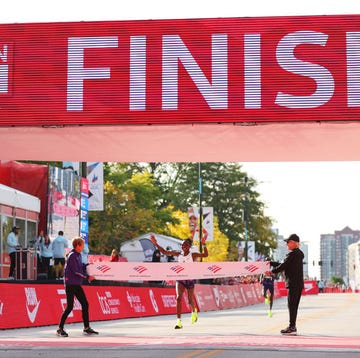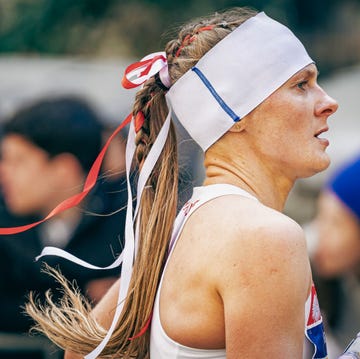Speak to any runner and there’s a near certainty that they will have experienced cramping at some point. From the humble stitch that is quite common among newbies to full-body spasms seen in ultra-distance epics, cramping is unfortunately par for the course.
But the most commonly reported cramping complaint among runners? Towards the end of a marathon – specifically around the mile-20 mark – excruciating spasms have derailed many a marathoners' PB attempt.
But with seemingly no definite scientific research as to what causes cramp in runners – albeit plenty of theories flying around – it can be hard to know what to do if cramps hit, and how to minimise your chances of getting them in the first place.
What everyone's reading
What is cramp and what causes it?
'Cramp is a small or localised spasm to a particular muscle,' explains senior physiologist and lab manager at Marylebone Health Jim Pate. 'That muscle goes into contraction and kind of stays there. When you feel it, you usually have a bit of a knot, but also when you press on it, it can be sore and tender.'
Cramps can be caused by lots of different things. For example, those who experience the rare HANAC syndrome – a genetic condition characterised by angiopathy, a disorder of the blood vessels – will commonly experience muscle cramps, and this typically begins in early childhood.
Some people also suffer from nocturnal leg cramps (NLCs) – leg spasms that typically occur at night – and these can be caused by everything from inactivity during the day, to pregnancy and a range of medical conditions.
Then there's the muscle cramps experienced by sportspeople – in particular runners – typically during or after high levels activity. The size and severity of these cramps can vary from some muscle fibres cramping to the full muscle spasming, which can be very painful.
There are three common places to get cramp during long-duration exercise – the abdomen, lower leg and hamstring. 'The runner's stitch – the muscle just underneath the ribcage – usually comes on fairly early on in your run, and you often get that with people who are unconditioned or new [to running]' explains Pate.
Stitches are also thought to be caused by the body still digesting food while on the run, resulting in less blood flowing to the diaphragm, which can induce spasms.
'Cramps in the lower leg and hamstring tend to strike later on in an event or training run,' continues Pate, 'but the truth is, no one knows the exact physiological conditions or causes. There's some speculation out there, but I think the truth probably lies in a clue that typically you start to see the incidence of these cramps increase when exercise is going longer than normal.'
The speculation that Pate refers to is centred around two different theories. The first, and oldest, is to do with dehydration and loss of electrolytes.
The idea is simple: when you sweat, you also secrete sodium – with the amount varying from person to person. Over long durations of exercise (such as running a marathon), your body’s total sodium stores are depleted, disturbing your electrolyte balance, and if you don’t replace them, it can cause cramps.
While the theory is based on observational or case-study-based data, rather than that generated in the lab, there is a 2019 paper that shows that the severity of cramps decreased (but weren’t completely prevented) when participants consumed a drink containing sodium while exercising.
> The best electrolyte drinks, powders and tablets <
The other, newer thinking, is that of the ‘neuromuscular’ theory, where essentially overloading the muscles – either by exercising too intensely (perhaps going off too hard) or beyond your body’s conditioning - longer than the furthest distance of your marathon training plan – causes electrical misfiring, resulting in cramp.
One of the main studies that proves this, while also disproving the loss of electrolytes theory, is a 2011 paper, published in the British Journal of Sports Medicine, which found that among 210 participants of an Ironman triathlon, those who suffered from cramp were those who had past history of cramping, or those who had gone off at a fast pace and therefore higher intensity.
Pate explains that the truth is probably somewhere in the middle, rather than it being solely explicable by one theory. 'There's probably something to do with volumetric overload and fatigue, but we also see the increased incidence of cramping usually during hot conditions in sport,' he says.
'If you put an athlete into a hot environment, it increases the intensity on the athlete relative to what they're normally used to dealing with. While you know that dehydration plays a role, if they increase running speed or have previously struggled with cramps, this is a better predictor of whether they're going to get cramps than whether they're dehydrated or whether they've got too much salt or not enough salt on board.'
This middle-ground is backed by a 2019 review, published in Sports Medicine, which concluded that the onset of cramp is ‘generally unpredictable’ and that the intensity and duration are ‘highly variable’.
How to prevent cramps
Although it’s not scientifically possible to say that cramps are explicitly caused by one thing over another, there are certainly ways to minimise the risk of getting them.
If your cramps are appearing at the end of a long training run or marathon, then there are a number of preventative steps you can do before, during and after each run.
'The majority of the time, it is going to be due to a lack of conditioning,' says Gary House, running coach at House Running Club. 'A lot of people – me included – might be entering a marathon quite early on in their running journey, so their [running] fitness is further ahead than that of their ligaments, tendons and muscles. Sometimes, it's just patience and acceptance, and hopefully with some months and years of training, then cramp just isn't an issue anymore because you've got that history of training behind you.'
He adds, though, that if you repeatedly get calf or hamstring cramps, then strengthening those areas with weight and plyometric exercises could increase their overall limits, and therefore reduce the risk of cramps. 'It can be a bit of a slow process and it might not prevent them each and every time, but at least you can hone in there.'
It’s an approach that’s also favoured by Parker: 'If we keep getting calf cramp, we'd want to do two or three main things, one of which will be doing a lot more strength and conditioning to strengthen the calves so that they can then tolerate the load of equivalent exercise without being maximally pushed. The other piece is increasing mobility, so stretching the calf area more – that's going to loosen up the muscle fibres and then allow more blood flow, which is going to help the muscles when it comes to being in that maximal position.'
While House believes that the hydration/electrolyte theory of cramping’s cause is limited to particular circumstances, for example, if you're racing in heat or in hot conditions that you're not used to, Parker believes that adding some sodium into the mix pre-, during- and post-exercise is a no-lose situation.
'Typically for myself, I'm not so much of a salty sweater, but at the same time if I'm doing a hot Ironman, or a hot marathon, I will likely take a salt tablet before starting and I'll also take electrolytes a little bit more proactively the day before to make sure I'm really well stocked up,' he says. 'For most people, I would say it's worthwhile preventatively addressing the situation, even if it's not necessary – you've got very little to lose [by taking on some extra electrolytes, because the drawback is zero.'
Finally, Pate flags that if your cramps are concerning you, then it might be worth seeing a sports doctor or physiotherapist. 'There's a chance that it might be a cramp that's not related to long-duration exercise, and that's where calling in specialists can help you figure that out.'
What to do if you get cramps during a marathon or training run
Overcoming cramps when they strike will depend on their severity and the situation you find yourself in. If the finish line is in sight and a PB is on the cards, it might be as simple as gritting your teeth and hobbling your way to the end, but it’s important to listen to your body to minimise any long-term issues.
'We know that stretching once you've got a cramp will help to alleviate it,' says Pate. 'Also, massaging away the stiffness or tension in the muscle is very good.'
House and Parker broadly agree, although Parker warns against pushing through the pain if the stakes are low. 'In training, we should be a lot more sensitive – you don't want to go and risk injury by pushing through and ruining your training month ahead.'
Finally, Pate concludes that, as the cramp can be caused by fatigue, getting some fuel in can help to restore the balance. 'If you're running out of gas and fatiguing, your body is probably starting to run a little bit low on its carb stores because you've been doing high-intensity stuff for a bit longer than normal.' So make sure you fuel your race properly, aiming to take on 30-60g of carbs per hour for the first three hours of your marathon, increasing to 60-90g of carbs per hour after that.


